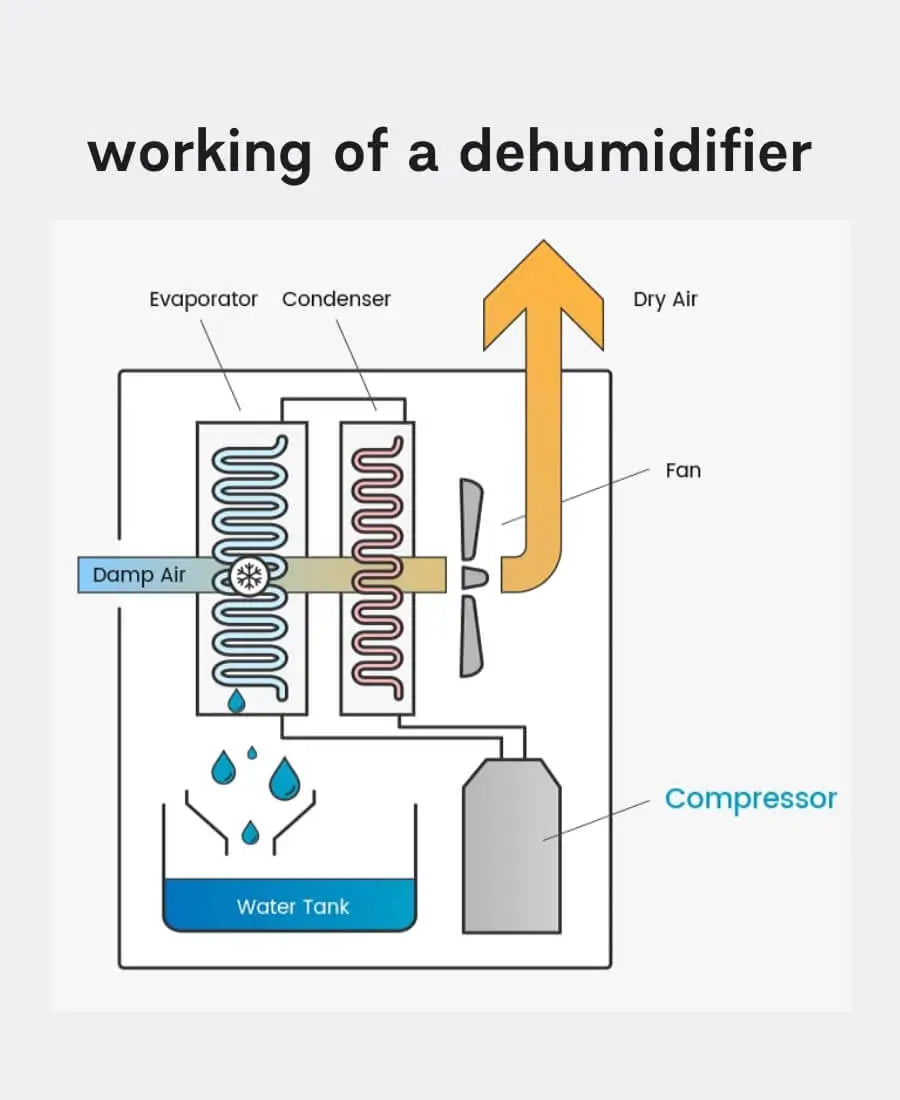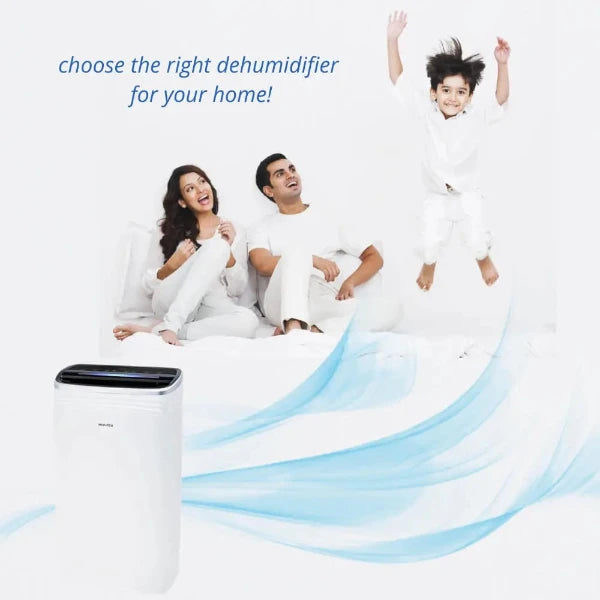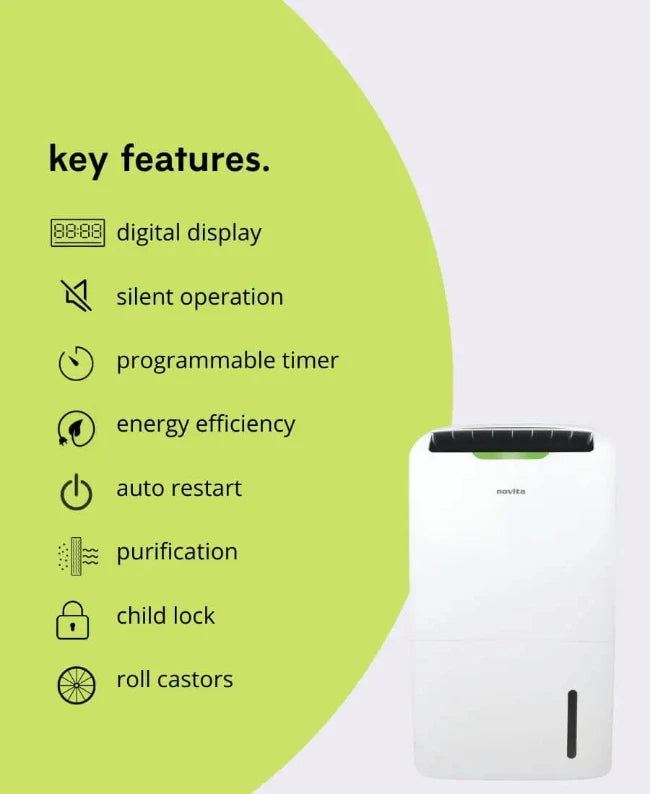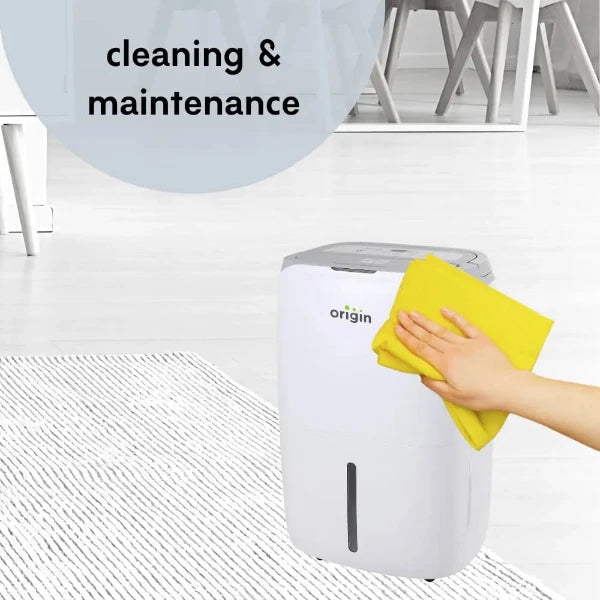
What is a dehumidifier?
A dehumidifier is an electrical appliance which reduces and maintains humidity level in the air. A dehumidifier is portable, comes with small wheels and can be moved around in different rooms very conveniently.
Dehumidifiers protect you and your family from health problems and safeguard your valuables from humidity damage contributing to a healthy indoor environment.
9 reasons you need a dehumidifier.
1. Prevent allergy triggers.
High humidity levels in our homes encourage flourishing of bacteria, virus and fungi which cause some of most common allergy triggers like stuffy nose, sneezing and difficulty in breathing and other respiratory infections. Dehumidifiers help a great deal in regulating the humidity levels in our homes to prevent allergy triggers from occurring.
2. Combat dust mites, mold, mildew and fungal growth.
Airborne allergens, dust mites, mold and fungi tend to thrive in high humidity areas. Dust mites are invisible occupants of our bedsheets, curtains and carpets. Mold and mildew are a cause for a number of health issues, they cause breathing difficulties like asthma and also triggers allergies. These organisms multiply in damp areas. Dehumidifiers reduce humidity levels which make your home less hospitable to these allergens and hinder their growth to prevent them from causing any health problems
3. Minimize damp interiors and improve comfort.
Damp walls and ceiling make our homes very uncomfortable; dampness is caused by excess moisture settling on our walls and ceilings. This affects the paint on walls, causes black spots to occur and damages our room interiors considerably. Dehumidifiers absorb excess moisture like a sponge and protect our home interiors ensuring a fresh, dry and comfortable indoor environment at all times.
4. Prevent musty odor and moldy upholstery.
Musty smell occurs from dampness in our homes, it is also a sign of mold growth and makes our rooms very stuffy. Moisture settling on the surface of upholstery lead to mold growth on upholstery. Dehumidifiers regulate the humidity levels and eliminate the lingering musty smell; dehumidifiers also restrict mold growth on the surface of upholstery and carpets.
5. Safeguard your clothing, shoes and leather articles.
In high moisture environment, wardrobe molds and musty odor also lead to growth of mold and mildew on our clothing, handbags and shoes - especially the ones that are made of leather. Moisture settles on the surface of these items and leads to black fuzzy dots and fungal growth. Rod dehumidifiers are very useful for in closet humidity control, these are dehumidifying bars which eliminate excess moisture and protects your belongings from moisture damage.
6. Protect breakdown of electronic appliances
High moisture levels are an enemy of sensitive electronic appliances. Moisture tends to build up inside the electronic equipment and condenses on the surface of chips and circuit boards which is why moisture is known to be the key factor of electronics-system failures. Consider using a dehumidifier in your home media center or living room area where we have you home theatre systems and music systems, dehumidifiers keep your electronics dry and safeguards them from moisture damage.
7. Care for your musical instruments
Musical instruments are delicate, how we store them plays a major role in how they perform and how long they will stay in tune. Instruments are mostly made of wood which is susceptible to moisture, when instruments are exposed to a moist environment it causes the wood to absorb moisture and glue joints to become weak. Incase of instruments like piano, excess moisture affects the tuning and cause the strings to rust. High humidity considerably shortens the lifespan and affects the performance of these instruments. Dehumidifiers regulate and maintain the right humidity levels to protect the musical instruments from moisture damage ensuring they perform at their best at all times.
8. Care for your paintings.
High and varying humidity levels cause discoloration of paintings, sagging of the painting canvas, growth of small brownish dots, mold and fungal growth all of which contribute to the deterioration of these paintings. Controlling humidity is a very important step towards preserving your painting.Your paintings will be at their happiest between 50-60% relative humidity. Dehumidifiers set and maintain constant humidity levels which safeguard your paintings and is very helpful in long-term preservation of your paintings.
9. Care for your collection of books.
Books are subject to rapid deterioration when exposed to high relative humidity. High humidity causes fading of ink and discoloration of paper. Excess moisture causes mold to germinate, it creates a hospitable environment for insects – all these factors have devastating effect on the quality of the books and shorten the lifespan of books considerably. Dehumidifiers are a preventive measure and play an important part inpreserving your collection of books from excess moisture.
If you need to know the exact humidity level in your home, get a hygrometer. A hygrometer is a digital device which measures the room humidity level and will identify whether or not you need a dehumidifier.

5 places in your home where you can use a dehumidifier
1. Bed Room and Living Room
When we are at home, we spend most of our time in the bedroom or living room area. It is very important to maintain a healthy indoor environment in these areas and humidity plays a major role in it. Dehumidifiers prove to be very helpful in preventing dampness in bedrooms that have condensation problems due to high humidity levels and low ac temperatures being set throughout the night. Asthma patients use dehumidifiers in bedrooms in the night as a controlled humidity environment gives them a lot of ease during their sleeping hours. In living rooms, dehumidifiers reduce the humidity levels and protect your room interiors and wooden furnishings. Dehumidifiers also safeguard your home theatre systems, musical instruments and other electronic appliances from moisture damage.
Using dehumidifiers in bedroom and living rooms also prevent mold, mildew and dust mites from occurring, they prevent the stuffiness caused by excess moisture and make the living room and bed rooms more fresh, dry and comfortable at all times.
2. Laundry Areas
Dehumidifiers absorb excess moisture from our garments, they also dry our damp clothes and prevent musty smell from occurring. Dehumidifiers are quick at laundry drying and are very energy efficient. Dehumidifiers consume very less power as compared to the traditional laundry dryers.
3. Walk in Wardrobes
Wardrobe molds and musty odor is very common in high humidity areas. Musty smell makes our clothes smelly and excess moisture leads to black spots and fungal growth on our clothing, handbags and other articles. For walk in wardrobes, the portable dehumidifier and rod dehumidifier, both are very effective, you can choose from either one which suits best for you. You can consider a portable dehumidifier if you would like to move it around in different rooms. Or else you can consider the rod dehumidifier. Rod dehumidifier is a dehumidifying bar that operates on warm air rising principle, it safely eliminates dampness and prevents mold, mildew and fungal growth.
4. Basements
Humidity often gets trapped in basements, poor air circulation in the basements make it even worse. Basements get very damp and musty. Humidity trapped in basement areas making it an ideal condition for the growth of dust mites, mold and mildew. Portable dehumidifiers help a great deal by absorbing excess moisture and regulating the humidity levels in basement areas. Dehumidifiers not only prevent dampness and musty odor in basements but also protect the furniture, electronic items and other articles we store in the basement from moisture damage
5. Coastal Areas
Homes that are in and around coastal areas or that are sea facing have high humidity levels throughout the year as the air absorbs moisture directly from the sea. High humidity levels cause the moisture to settle on walls and make them damp, it settles on electronic appliances and leads to malfunction, also becomes a root cause for growth of dust mites, mold and mildew which trigger allergic reactions. So, a little more care and maintenance is required in these homes and having a dehumidifier in these homes will ensure controlled and consistent humidity levels throughout the year, thereby protecting your health, preventing growth of allergens and safeguarding your valuables from getting affected.


How does a refrigerant dehumidifier work?
Step 1: The dehumidifier draws moisture filled air from the surrounding and passes the air through cold refrigerated coils.
Step 2: The water condenses on the cold coils and the condensed water droplets are collected in the dehumidifier water tank.
Step 3: Then the air is passed over a warm condenser coil and reheated.
Step 4: The dehumidified warm air is now released in the room and the process is carried on to meet the desired humidity level.

4 quick questions to help you identify the right dehumidifier for your space.
1. Space in which you want to use the dehumidifier.
Identifying the space that requires dehumidification, if its one single room or more than one room that needs dehumidification. Whether you would like to buy one dehumidifier and move it around in different rooms or buy separate dehumidifiers for each room.
2. Level of dampness in the room.
Look for the visible signs of high humidity basis on which you can decide the capacity that will suite your needs the best. If you require basic humidity control, you can start with the basic models. If the humidity level is high or the room is very damp, you might want to consider a higher capacity model which will absorb more moisture and dehumidify the room faster.
3. If there's any specific need for dehumidification that needs to be addressed.
You need to identify if there's what are some of the major issues your facing with humidity and consider buying the dehumidifier with features that will best serve your dehumidification needs. You can always speak to a humidity expert to understand the difference between different dehumidifier models and the features that will be the most suitable for your needs.
4. Size of the room that needs to be dehumidified.
Dehumidifier Sizing Table
| Condition of the Space | Upto 200 sq ft | Upto 300 sq ft | Upto 400 sq ft | Upto 600 sq ft |
| Slightly Damp | 12 ltrs | 20 ltrs | 30 ltrs | 50 ltrs |
| Moderately Damp | 12-20 ltrs | 20-30 ltrs | 30 ltrs | 50 ltrs |
| Very Damp | 20 ltrs | 30 ltrs | 35 ltrs | 50-60 ltrs |
| Wet Conditions | 20 ltrs | 20-30 ltrs | 30-35 ltrs | 50-60 ltrs |
Installing and operating your dehumidifier the right way.
Step 1
Close the doors and windows in the room where you run the dehumidifier. To ensure maximum efficiency, place the dehumidifier in an area where air can circulate well and the dehumidifier can cover the entire room area
Step 2
Press the on/off button to switch on the dehumidifier.
Step 3
Select the dehumidifying mode and fan speed as per your needs.
Step 4
If you have selected the manual mode, then you can set the humidity % you want to maintain.
Step 5
(i)Select the other functions that the dehumidifier offers, it could be air purification, child lock function, oscillation outlet as per your requirement.
(ii)If the dehumidifier has timer function, then click on timer which will program your dehumidifier to run for the selected number of hours.
Step 6
(i) The dehumidifier will shut off automatically when the tank is full. Remove the water tank and empty it. Place the tank back in the dehumidifier to resume operation.
(ii)If you opt for continuous drainage, then turn off the power supply and unplug the dehumidifier. Remove the water tank from the unit and insert pvc hose of the correct diameter through the drainage outlet. Please ensure the dehumidifier is kept on a stable surface and the hose is connected properly. The hose is placed in a downward angle and is not bent or folded. This is to make sure there is smooth flow of water. Now place the water tank back in the unit and the dehumidifier is now ready for continuous drainage. (Please note: Contact the service team for assistance while opting for continuous drainage, they will visit the site to complete the setup or assist you with the steps. A professional assistance is recommended for setting up drainage.)


8 must have features in a dehumidifier
1. Digital display, to view and set the humidity levels
2. Programmable timer, to program the dehumidifier according to your needs.
3. Air purification mode, complete or semi-purification will enable your dehumidifier to dehumidify and purify at the same time
4. Auto restart, resumes operation when power comes on.
5. Energy efficiency, so that the dehumidifier consumes less power during operation hours.
6. Childlock function, to prevent mishandling of the dehumidifier operating mode.
7. Roll castors, for easy mobility of the dehumidifier.

5 things a first-time dehumidifier user should know.
1. When using your dehumidifier in the first week, the water tank will be full everyday as the dehumidifier will draw in the high moisture content from the surrounding and will also absorb the moisture from your walls, ceilings etc. In the following week, the frequency of the water tank filling in will depend on the level of humidity in the environment.
2. Clean the pre-filter once in a week. Clean the dehumidifier water tank once in a month.
3. Please do not use the dehumidifier continuously for more than 12 hours and give a break for an hour before restarting to avoid the unit from malfunctioning or catching fire.
4. If the dehumidifier is run on continuous mode or drainage has been setup, then using an external timer is mandatory which will ensure the machine gets proper rest and is not over-heated/over-worked.
5. Servicing should be conducted only by authorized service technician.

3 easy steps to keep your dehumidifier clean.
Step 1 : Disconnect the dehumidifier from power supply when the dehumidifier is not in use or you want to clean the dehumidifier.
Step 2 : Use a soft damp cloth and wipe out the dust from the dehumidifier housing / outer case
Step 3 : To clean the filter, use a vacuum cleaner or brush to remove the dirt, do not use soap or keep the filter under water.
Please note: Servicing of the dehumidifier should be conducted only by authorized service technician only.
We are here to help. If you have any questions, please reach out to us on:
for sales: 9152004949 / 02249267267 or write to us response@origincorp.com
for service: 02249267202 or write to use at service@origincorp.com
